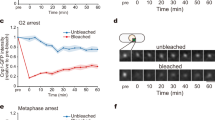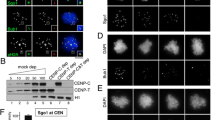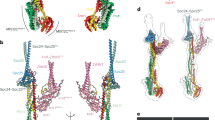Abstract
Faithful chromosome segregation during mitosis requires the correct assembly of kinetochore on the centromere. CENP-A is a variant of histone H3, which specializes the centromere region on chromatin and mediates the kinetochore assembly. The Mis18 complex plays a critical role in initiating the centromere loading of the newly-synthesized CENP-A. However, it remains unclear how Mis18 complex (spMis18, spMis16 and spMis19) is located to the centromere to license the recruitment of Cnp1CENP-A in Schizosaccharomyces pombe. We found that spMis18 directly binds to nucleosomal DNA through its extreme C-terminus and interacts with H2A–H2B dimer via the acidic region on the surface of its Yippee-like domain. Live-cell imaging confirmed that mutation of the acidic region and deletion of the extreme C-terminus significantly impairs the localization of spMis18 and Cnp1 to the centromere and delays chromosome segregation during mitosis. Our findings illustrate that the interaction of spMis18 with histone H2A–H2B and DNA plays important roles in the recruitment of spMis18 and Cnp1 to the centromere in fission yeast.





Similar content being viewed by others
Abbreviations
- CD:
-
Circular dichroism
- CCD:
-
Charge-coupled device
- CENP:
-
Centromere protein
- FL:
-
Full length
- GADPH:
-
Glyceraldehyde-3-phosphate dehydrogenase
- GFP:
-
Green fluorescent protein
- GST:
-
Glutathione S-transferase
- HJURP:
-
Holliday junction recognition protein
- IPTG:
-
Isopropyl 1-β-d-galactopyranoside
- LB:
-
Luria-Bertani
- M18BP1:
-
Mis18 binding protein 1
- NCP:
-
Nucleosome
- Ni–NTA:
-
Nickel–nitriloacetic acid
- PAGE:
-
Polyacrylamide gel electrophoresis
- PCR:
-
Polymerase chain reaction
- PMSF:
-
Phenylmethylsulfonyl fluoride
- RSF1:
-
Remodeling and spacing factor 1
- SAD:
-
Single-wavelength anomalous dispersion
- SEC:
-
Size-exclusion chromatography
- MALS:
-
Multiangle light scattering
- SDS:
-
Sodium dodecyl sulfate
- SSRF:
-
Shanghai synchrotron radiation facility
- TEV:
-
Tobacco etch virus
- Tris:
-
Tris(hydroxymethyl)aminomethane
- Trx:
-
Thioredoxin
- WT:
-
Wild type
References
McKinley KL, Cheeseman IM (2016) The molecular basis for centromere identity and function. Nat Rev Mol Cell Biol 17(1):16–29
Earnshaw WC, Rothfield N (1985) Identification of a family of human centromere proteins using autoimmune sera from patients with scleroderma. Chromosoma 91(3–4):313–321
Earnshaw WC, Migeon BR (1985) Three related centromere proteins are absent from the inactive centromere of a stable isodicentric chromosome. Chromosoma 92(4):290–296
Westhorpe FG, Straight AF (2013) Functions of the centromere and kinetochore in chromosome segregation. Curr Opin Cell Biol 25(3):334–340
Stellfox ME, Bailey AO, Foltz DR (2013) Putting CENP-A in its place. Cell Mol Life Sci 70(3):387–406
Fujita Y, Hayashi T, Kiyomitsu T, Toyoda Y, Kokubu A, Obuse C, Yanagida M (2007) Priming of centromere for CENP-A recruitment by human hMis18alpha, hMis18beta, and M18BP1. Dev Cell 12(1):17–30
Dunleavy EM, Roche D, Tagami H, Lacoste N, Ray-Gallet D, Nakamura Y, Daigo Y, Nakatani Y, Almouzni-Pettinotti G (2009) HJURP is a cell-cycle-dependent maintenance and deposition factor of CENP-A at centromeres. Cell 137(3):485–497
Foltz DR, Jansen LE, Bailey AO, Yates JR 3rd, Bassett EA, Wood S, Black BE, Cleveland DW (2009) Centromere-specific assembly of CENP-a nucleosomes is mediated by HJURP. Cell 137(3):472–484
Shuaib M, Ouararhni K, Dimitrov S, Hamiche A (2010) HJURP binds CENP-A via a highly conserved N-terminal domain and mediates its deposition at centromeres. Proc Natl Acad Sci USA 107(4):1349–1354
Lagana A, Dorn JF, De Rop V, Ladouceur AM, Maddox AS, Maddox PS (2010) A small GTPase molecular switch regulates epigenetic centromere maintenance by stabilizing newly incorporated CENP-A. Nat Cell Biol 12(12):1186–1193
Liu C, Mao Y (2017) Formin-mediated epigenetic maintenance of centromere identity. Small GTPases 8(4):245–250
Perpelescu M, Nozaki N, Obuse C, Yang H, Yoda K (2009) Active establishment of centromeric CENP-A chromatin by RSF complex. J Cell Biol 185(3):397–407
Bergmann JH, Rodriguez MG, Martins NM, Kimura H, Kelly DA, Masumoto H, Larionov V, Jansen LE, Earnshaw WC (2011) Epigenetic engineering shows H3K4me2 is required for HJURP targeting and CENP-A assembly on a synthetic human kinetochore. EMBO J 30(2):328–340
Bailey AO, Panchenko T, Shabanowitz J, Lehman SM, Bai DL, Hunt DF, Black BE, Foltz DR (2016) Identification of the post-translational modifications present in centromeric chromatin. Mol Cell Proteom 15(3):918–931
Shang WH, Hori T, Westhorpe FG, Godek KM, Toyoda A, Misu S, Monma N, Ikeo K, Carroll CW, Takami Y, Fujiyama A, Kimura H, Straight AF, Fukagawa T (2016) Acetylation of histone H4 lysine 5 and 12 is required for CENP-A deposition into centromeres. Nat Commun 7:13465
Chan FL, Marshall OJ, Saffery R, Kim BW, Earle E, Choo KH, Wong LH (2012) Active transcription and essential role of RNA polymerase II at the centromere during mitosis. Proc Natl Acad Sci USA 109(6):1979–1984
Dambacher S, Deng W, Hahn M, Sadic D, Frohlich J, Nuber A, Hoischen C, Diekmann S, Leonhardt H, Schotta G (2012) CENP-C facilitates the recruitment of M18BP1 to centromeric chromatin. Nucleus 3(1):101–110
Stellfox ME, Nardi IK, Knippler CM, Foltz DR (2016) Differential binding partners of the Mis18alpha/beta YIPPEE domains regulate Mis18 complex recruitment to centromeres. Cell Rep 15(10):2127–2135
Hori T, Shang WH, Hara M, Ariyoshi M, Arimura Y, Fujita R, Kurumizaka H, Fukagawa T (2017) Association of M18BP1/KNL2 with CENP-A nucleosome is essential for centromere formation in non-mammalian vertebrates. Dev Cell 42(2):181–189 (e183)
Moree B, Meyer CB, Fuller CJ, Straight AF (2011) CENP-C recruits M18BP1 to centromeres to promote CENP-A chromatin assembly. J Cell Biol 194(6):855–871
French BT, Westhorpe FG, Limouse C, Straight AF (2017) Xenopus laevis M18BP1 directly binds existing CENP-A nucleosomes to promote centromeric chromatin assembly. Dev Cell 42(2):190–199 (e110)
Hayashi T, Ebe M, Nagao K, Kokubu A, Sajiki K, Yanagida M (2014) Schizosaccharomyces pombe centromere protein Mis19 links Mis16 and Mis18 to recruit CENP-A through interacting with NMD factors and the SWI/SNF complex. Genes Cells Devoted Mol Cell Mech 19(7):541–554
An S, Kim H, Cho US (2015) Mis16 independently recognizes histone H4 and the CENP-ACnp1-specific chaperone Scm3sp. J Mol Biol 427(20):3230–3240
Subramanian L, Medina-Pritchard B, Barton R, Spiller F, Kulasegaran-Shylini R, Radaviciute G, Allshire RC, Arockia Jeyaprakash A (2016) Centromere localization and function of Mis18 requires Yippee-like domain-mediated oligomerization. EMBO Rep 17(4):496–507
Wang QS, Zhang KH, Cui Y, Wang ZJ, Pan QY, Liu K, Sun B, Zhou H, Li MJ, Xu Q, Xu CY, Yu F, He JH (2018) Upgrade of macromolecular crystallography beamline BL17U1 at SSRF. Nucl Sci Tech 29(5):68
Collaborative Computational Project N (1994) The CCP4 suite: programs for protein crystallography. Acta Crystallogr D Biol Crystallogr 50(Pt 5):760–763
Terwilliger TC, Grosse-Kunstleve RW, Afonine PV, Moriarty NW, Zwart PH, Hung LW, Read RJ, Adams PD (2008) Iterative model building, structure refinement and density modification with the PHENIX AutoBuild wizard. Acta Crystallogr D Biol Crystallogr 64(Pt 1):61–69
McCoy AJ, Grosse-Kunstleve RW, Adams PD, Winn MD, Storoni LC, Read RJ (2007) Phaser crystallographic software. J Appl Crystallogr 40(Pt 4):658–674
Emsley P, Cowtan K (2004) Coot: model-building tools for molecular graphics. Acta Crystallogr D Biol Crystallogr 60(Pt 12 Pt 1):2126–2132
Murshudov GN, Skubak P, Lebedev AA, Pannu NS, Steiner RA, Nicholls RA, Winn MD, Long F, Vagin AA (2011) REFMAC5 for the refinement of macromolecular crystal structures. Acta Crystallogr D Biol Crystallogr 67(Pt 4):355–367
Bahler J, Wu JQ, Longtine MS, Shah NG, McKenzie A 3rd, Steever AB, Wach A, Philippsen P, Pringle JR (1998) Heterologous modules for efficient and versatile PCR-based gene targeting in Schizosaccharomyces pombe. Yeast 14(10):943–951
Tran PT, Paoletti A, Chang F (2004) Imaging green fluorescent protein fusions in living fission yeast cells. Methods 33(3):220–225
Hayashi T, Fujita Y, Iwasaki O, Adachi Y, Takahashi K, Yanagida M (2004) Mis16 and Mis18 are required for CENP-A loading and histone deacetylation at centromeres. Cell 118(6):715–729
Acknowledgements
We thank the staff at beamline BL17U1 of the Shanghai Synchrotron Radiation Facility of the National Facility for Protein Science in Shanghai for assistance with data collection. This work was supported by the National Key Research and Development Program of China (2017YFA0503600, 2016YFA0400903), the Foundation for Innovative Research Groups of the National Natural Science Foundation of China (31621002), the Innovative Program of Development Foundation of Hefei Center for Physical Science and Technology (2017FXCX004), Users with Excellence Project of Hefei Science Center CAS (2018HSC-UE001), the National Natural Science Foundation of China (U1532109, 91853133 to JZ, 31700671 to XZ), and USTC Research Funds of the Double First-Class Initiative.
Author information
Authors and Affiliations
Contributions
JZ, XZ provided the scientific direction and the overall experimental design for the studies. CF and FZ provided the experimental design for in vivo studies. MZ, XZ and CS performed the biochemical experiments. MZ carried out the in vivo biochemistry experiments. FZ and MZ constructed the yeast strains. FZ performed live-cell imaging. MZ analyzed the imaging results with the help from FZ. XN and FD provided assistance in the biochemical experiments in fission yeast. CS, CW and MW were responsible for the crystal structure studies. MZ, FZ, XZ, CF and JZ wrote the manuscript.
Corresponding authors
Ethics declarations
Conflict of interest
The authors declare that they have no conflict of interest.
Additional information
Publisher's Note
Springer Nature remains neutral with regard to jurisdictional claims in published maps and institutional affiliations.
Electronic supplementary material
Below is the link to the electronic supplementary material.
Rights and permissions
About this article
Cite this article
Zhang, M., Zheng, F., Xiong, Y. et al. Centromere targeting of Mis18 requires the interaction with DNA and H2A–H2B in fission yeast. Cell. Mol. Life Sci. 78, 373–384 (2021). https://doi.org/10.1007/s00018-020-03502-1
Received:
Revised:
Accepted:
Published:
Issue Date:
DOI: https://doi.org/10.1007/s00018-020-03502-1




